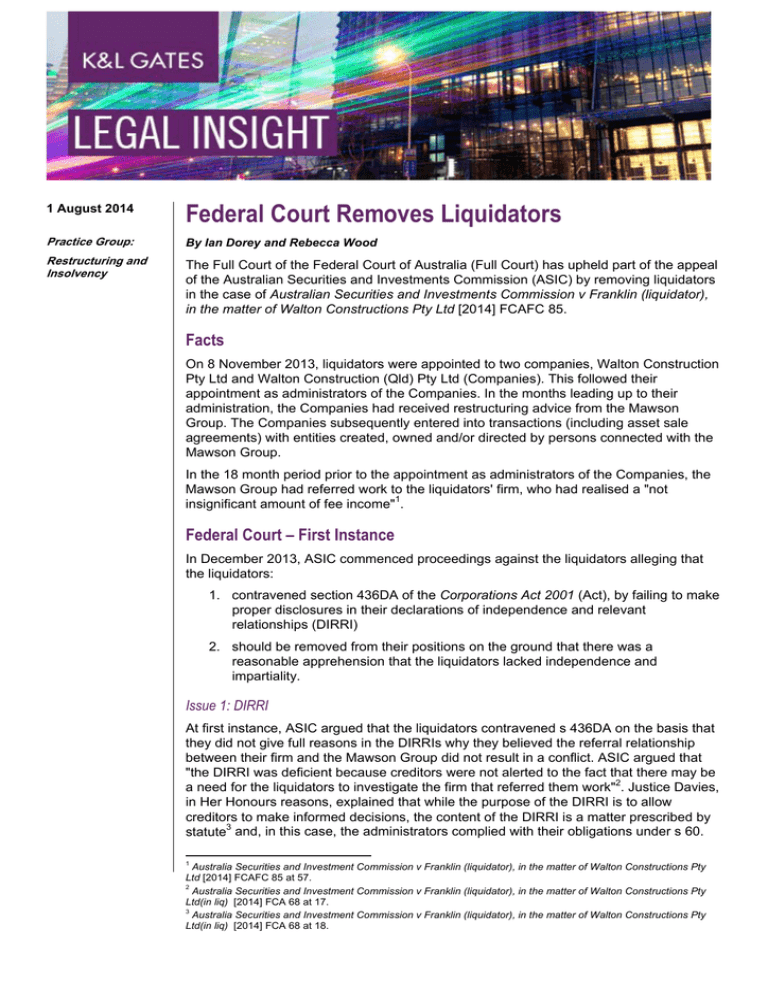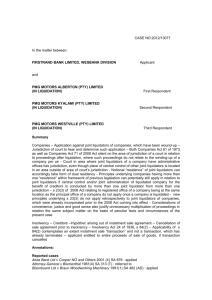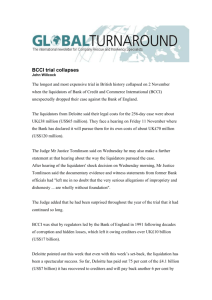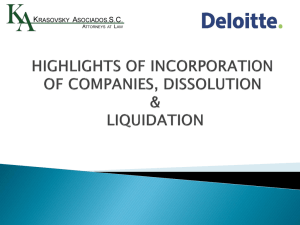Federal Court Removes Liquidators
advertisement

1 August 2014 Federal Court Removes Liquidators Practice Group: By Ian Dorey and Rebecca Wood Restructuring and Insolvency The Full Court of the Federal Court of Australia (Full Court) has upheld part of the appeal of the Australian Securities and Investments Commission (ASIC) by removing liquidators in the case of Australian Securities and Investments Commission v Franklin (liquidator), in the matter of Walton Constructions Pty Ltd [2014] FCAFC 85. Facts On 8 November 2013, liquidators were appointed to two companies, Walton Construction Pty Ltd and Walton Construction (Qld) Pty Ltd (Companies). This followed their appointment as administrators of the Companies. In the months leading up to their administration, the Companies had received restructuring advice from the Mawson Group. The Companies subsequently entered into transactions (including asset sale agreements) with entities created, owned and/or directed by persons connected with the Mawson Group. In the 18 month period prior to the appointment as administrators of the Companies, the Mawson Group had referred work to the liquidators' firm, who had realised a "not insignificant amount of fee income"1. Federal Court – First Instance In December 2013, ASIC commenced proceedings against the liquidators alleging that the liquidators: 1. contravened section 436DA of the Corporations Act 2001 (Act), by failing to make proper disclosures in their declarations of independence and relevant relationships (DIRRI) 2. should be removed from their positions on the ground that there was a reasonable apprehension that the liquidators lacked independence and impartiality. Issue 1: DIRRI At first instance, ASIC argued that the liquidators contravened s 436DA on the basis that they did not give full reasons in the DIRRIs why they believed the referral relationship between their firm and the Mawson Group did not result in a conflict. ASIC argued that "the DIRRI was deficient because creditors were not alerted to the fact that there may be a need for the liquidators to investigate the firm that referred them work"2. Justice Davies, in Her Honours reasons, explained that while the purpose of the DIRRI is to allow creditors to make informed decisions, the content of the DIRRI is a matter prescribed by statute3 and, in this case, the administrators complied with their obligations under s 60. 1 Australia Securities and Investment Commission v Franklin (liquidator), in the matter of Walton Constructions Pty Ltd [2014] FCAFC 85 at 57. 2 Australia Securities and Investment Commission v Franklin (liquidator), in the matter of Walton Constructions Pty Ltd(in liq) [2014] FCA 68 at 17. 3 Australia Securities and Investment Commission v Franklin (liquidator), in the matter of Walton Constructions Pty Ltd(in liq) [2014] FCA 68 at 18. The liquidators had outlined their relationship with the Mawson Group in the DIRRI and gave the reason: "referrals from solicitors, business advisors and accountants are common place and do not impact on our independence in carrying out our functions as Administrators".4 Justice Davies stated that "if there be any conflict of interest or duty, it was founded in the referral relationship, the nature of which was disclosed".5 ASIC's application on this point failed. Issue 2: Apprehension of Bias Section 503 gives the court the power to remove a liquidator, on cause shown, in a voluntary winding up and appoint another liquidator. In considering 'cause shown', the court will look at evidence of conduct or lack of conduct, including lack of independence and apprehension of bias. ASIC argued that there was a reasonable apprehension of bias because the liquidators had a conflict of interest, arising from their relationship with the Mawson Group. It was common ground that the test for apprehended bias was the same test that applies to the judiciary and is whether "a fair-minded lay observer might reasonably apprehend that the judge might not bring an impartial mind to the resolution of the question the judge is required to decide"6. Justice Davies dismissed ASIC's claim, stating that a fair-minded observer, appropriately informed, would be aware that: a) the liquidators are under a statutory obligation to investigate voidable transactions, unlawful conduct and potential criminal conduct b) the firm is commonly referred work from solicitors, business advisors and accountants c) the relationship between the Mawson Group and the firm was a professional one. Therefore, the fair-minded observer may reasonably conclude that the liquidators would carry out their statutory duties uninfluenced despite their relationship with the Mawson Group. Appeal to Full Court ASIC appealed the decision to the Full Court. Referring back to the issues raised at 'Federal Court – First Instance': Issue 1: DIRRI The Full Court agreed with the primary judge on this issue. It was decided that requiring the administrators to give reasons as to why there was no perception of a lack of independence when they were investigating a person with whom they had a material referral relationship and who was involved in their appointment, expands the obligation on an administrator beyond the requirements of s 60(1)(b)7. 4 Australia Securities and Investment Commission v Franklin (liquidator), in the matter of Walton Constructions Pty Ltd(in liq) [2014] FCA 68 at 11. 5 Australia Securities and Investment Commission v Franklin (liquidator), in the matter of Walton Constructions Pty Ltd(in liq) [2014] FCA 68 at 21. 6 Ebner v Official Trustee in Bankruptcy [2000] HCA 63 at 6. 7 Australia Securities and Investment Commission v Franklin (liquidator), in the matter of Walton Constructions Pty Ltd [2014] FCAFC 85 at 34. 2 Justice Robertson commented that the Insolvency Practitioners Association of Australia's (as it then was, now Australian Restructuring Insolvency and Turnaround Association (ARITA)) Code of Professional Practice for Insolvency Practitioners (Code) should not be taken into account in construing the Act. Issue 2: Apprehension of Bias The Full Court used the same test for whether there is an "apprehension of bias" as was used at first instance. However, the Full Court found that the judge at first instance erred in concluding that there was no real apprehension of bias. Justice White noted in his reasoning that "the guiding principle is that a liquidator must be independent and be seen to be independent"8 and that an appearance of bias arising by association is a recognised category of disqualification.9 He concluded that there was in this case a conflict which was more than theoretical between the interest of the firm in not jeopardising the prospect of further remunerative referrals from the Mawson Group, and the proper discharge of their duties as liquidators of the Companies. Justice White formed the view that a reasonable fair-minded observer would perceive this conflict.10 He also found that a reasonable fair-minded observer might reasonably apprehend that, because of the liquidators' interest in not jeopardising future income, they might not discharge their duties with independence and impartiality.11 As a result, the Full Court found it had no alternative but to remove the liquidators. The final order was published on 29 July 2014, stating that the liquidators were removed and replacement liquidators appointed. Costs were awarded against the liquidators and the Companies. How Will this Affect You? ARITA has responded to the decision of the Full Court by inserting a new s 6.6.1 into the Code, which requires insolvency practitioners to disclose in the DIRRI the referring entity and practitioner's reasons why the relationship with the referrer does not result in a conflict of interest or duty. Practically, the Code requirement for declaring referral relationships in the DIRRI does not make it any clearer whether such a relationship gives rise to an 'apprehension of bias'. That will still be a matter of fact, which may be subject to consideration of the court where it is in contention. While the referral relationship may weaken the practitioner's appearance of independence, there will still be a test of whether a reasonable fairminded observer would perceive there to be a conflict as a result. This case and the subsequent changes to the Code by ARITA reinforce the fact that insolvency practitioners should not only be independent but be seen to be independent. If practitioners have any doubt, it is best not to take on the appointment or if challenged, consider resigning. While the Full Court did not go as far as ASIC wanted it to do, administrators and liquidators will have to examine their relationships to ensure that there will be no appearance or real apprehension of bias. 8 Re Queensland Stations Pty Ltd (In Liq) [1991] FCA 469. Australia Securities and Investment Commission v Franklin (liquidator), in the matter of Walton Constructions Pty Ltd [2014] FCAFC 85 at 57. 10 Australia Securities and Investment Commission v Franklin (liquidator), in the matter of Walton Constructions Pty Ltd [2014] FCAFC 85 at 124. 11 Australia Securities and Investment Commission v Franklin (liquidator), in the matter of Walton Constructions Pty Ltd [2014] FCAFC 85 at 125. 9 3 Authors: Ian Dorey ian.dorey@klgates.com +61.7.3233.1236 Rebecca Wood rebecca.wood@klgates.com +61.7.3233.1277 Anchorage Austin Beijing Berlin Boston Brisbane Brussels Charleston Charlotte Chicago Dallas Doha Dubai Fort Worth Frankfurt Harrisburg Hong Kong Houston London Los Angeles Melbourne Miami Milan Moscow Newark New York Orange County Palo Alto Paris Perth Pittsburgh Portland Raleigh Research Triangle Park San Diego San Francisco São Paulo Seattle Seoul Shanghai Singapore Spokane Sydney Taipei Tokyo Warsaw Washington, D.C. Wilmington K&L Gates comprises more than 2,000 lawyers globally who practice in fully integrated offices located on five continents. The firm represents leading multinational corporations, growth and middle-market companies, capital markets participants and entrepreneurs in every major industry group as well as public sector entities, educational institutions, philanthropic organizations and individuals. For more information about K&L Gates or its locations, practices and registrations, visit www.klgates.com. This publication is for informational purposes and does not contain or convey legal advice. The information herein should not be used or relied upon in regard to any particular facts or circumstances without first consulting a lawyer. © 2014 K&L Gates LLP. All Rights Reserved. 4





![FORM NO. 157 [See rule 331] COMPANIES ACT. 1956 Members](http://s3.studylib.net/store/data/008659599_1-2c9a22f370f2c285423bce1fc3cf3305-300x300.png)